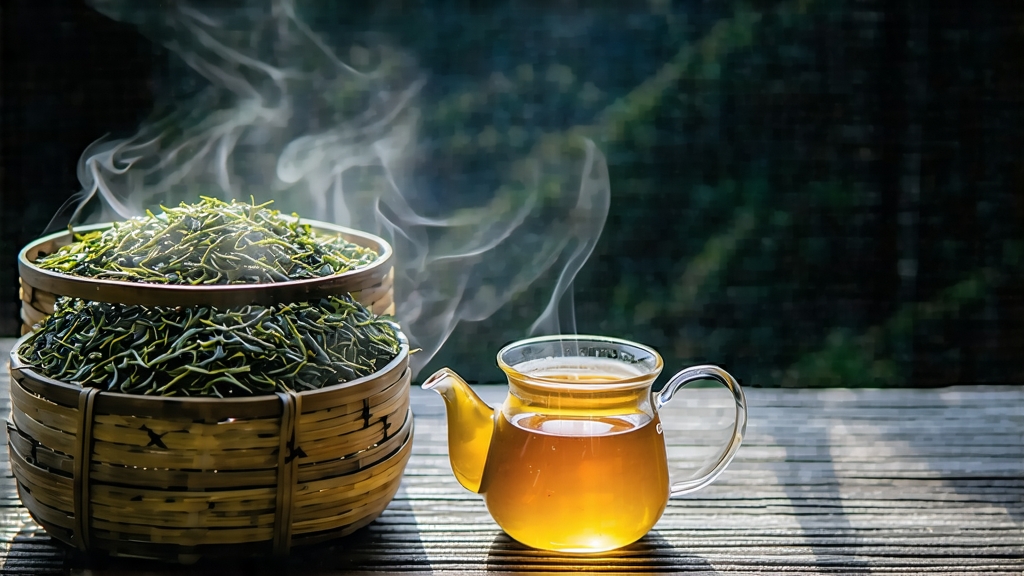
Liu Bao cha, literally “Six Forts tea,” takes its name from the six historical stockade villages that once lined the trade route between the mist-wrapped mountains of Guangxi and the Pearl River delta. For more than fifteen centuries this quietly powerful dark tea has been the traveling companion of merchants, miners, and maritime porters, its flavor evolving in time with the pulse of human movement. While Pu-erh has become the global shorthand for Chinese post-fermented tea, Liu Bao remains a connoisseur’s secret: deeper, rounder, and laced with the scent of damp earth, betel nut, and long-forgotten incense.
History begins in the Tang dynasty, when mountain-dwelling Yao and Han farmers discovered that a brief piling and steaming of their sun-withered leaves produced a dark, soothing brew that calmed stomachs exhausted by humid subtropical summers. By the Qing era the tea was pressed into 40-kilogram baskets, loaded onto mule caravans, and marched to the port of Wuzhou, where it was transferred onto bamboo rafts bound for Hong Kong and, eventually, the dim-sum parlors of Kuala Lumpur. On arrival in Southeast Asia the tea was credited with dispelling the “heat” of tropical cuisine; miners in the tin belts of Perak swore that a morning cup prevented malaria and cured beriberi. Such medicinal reputation turned Liu Bao into currency: baskets were mortgaged, traded for opium, or stashed in clan temples as dowry wealth. Today the same trade route is a heritage corridor, and the tea is protected under China’s National Geographic Indication.
Although Liu Bao belongs to the hei cha (dark tea) family, it is not a single cultivar but a processing method applied to the large-leaf Camellia sinensis var. sinensis bushes that root themselves in the red lateritic soils of Guangxi’s Da Wu and Cangwu counties. Growers speak of three micro-origins—Tongping, Yingtang, and Gao Song—each offering a different ratio of quartz to granite in the soil, translating into subtle variations in sweetness, thickness, and after-aroma. Old-garden trees aged 80–300 years survive on terraced slopes too steep for machinery; their roots intertwine with ferns and wild camphor, absorbing resinous notes that later emerge in the cup as cooling menthol and camphor-bark sweetness.
The craft begins in late April when the first spring flush reaches “small open” size—three leaves and a bud still tipped in down. Pickers pluck only in the morning while the dew is intact, believing that moisture prevents mechanical bruising during the two-hour trek down to the village. Once in the barn the leaves are spread on split-bamboo mats for 4–6 hours of sun-withering, a shorter interval than for oolong because the goal is to retain interior moisture for the forthcoming “dui wo” piling. When the lamina feels leathery but the stem remains brittle, the leaves are sent to a wok heated to 160 °C where they are tossed for three minutes—just long enough to denature polyphenol oxidase without sealing the surface. This “sha qing” (kill-green) step is lighter than for green tea, leaving a living substrate for microbial colonization.
Rolling follows, performed on a 1.2-meter bamboo tray: the master grips the leaf pile with both palms and presses forward in a spiral motion, rupturing 30–35 % of the cells and releasing sticky juices that will later act as glue for the basket press. The crucial divergence from sheng Pu-erh occurs next. The rolled leaves are heaped 70 cm deep inside a pine-lined wooden chamber, sprayed with a fine mist of Wuzhou’s mineral-rich well water, and covered with jute sacks. Inside this compost-like mound the temperature climbs to 55 °C within 24 hours; thermophilic bacteria belonging to Bacillus and Aspergillus species bloom, converting catechins into theabrownins and breaking down bitter caffeine into milder theophylline. Every two days the pile is turned by fork, and every four days it is restacked, a rhythm maintained for fifteen to twenty-five days depending on ambient humidity. When the leaf core turns walnut-brown and exudes the scent of dried longan, the piling halts.
Post-fermentation is arrested by firing the leaves